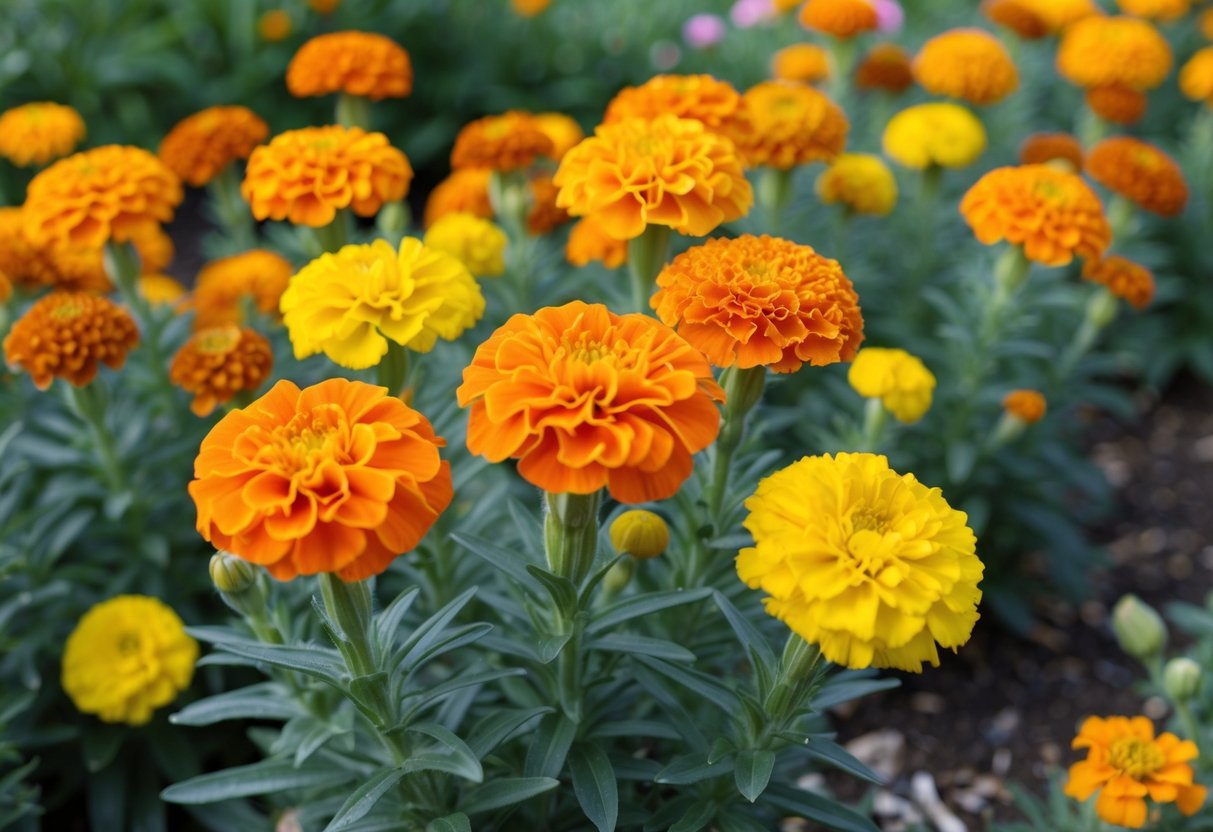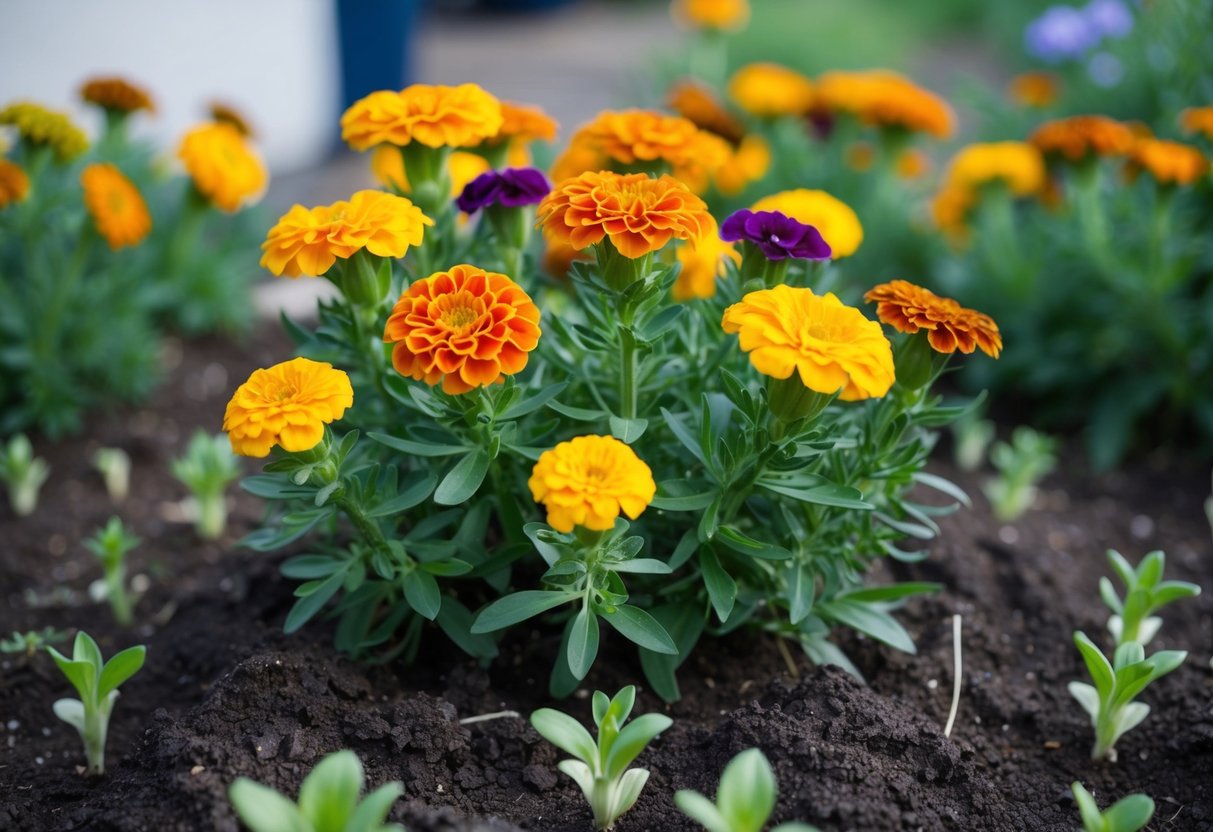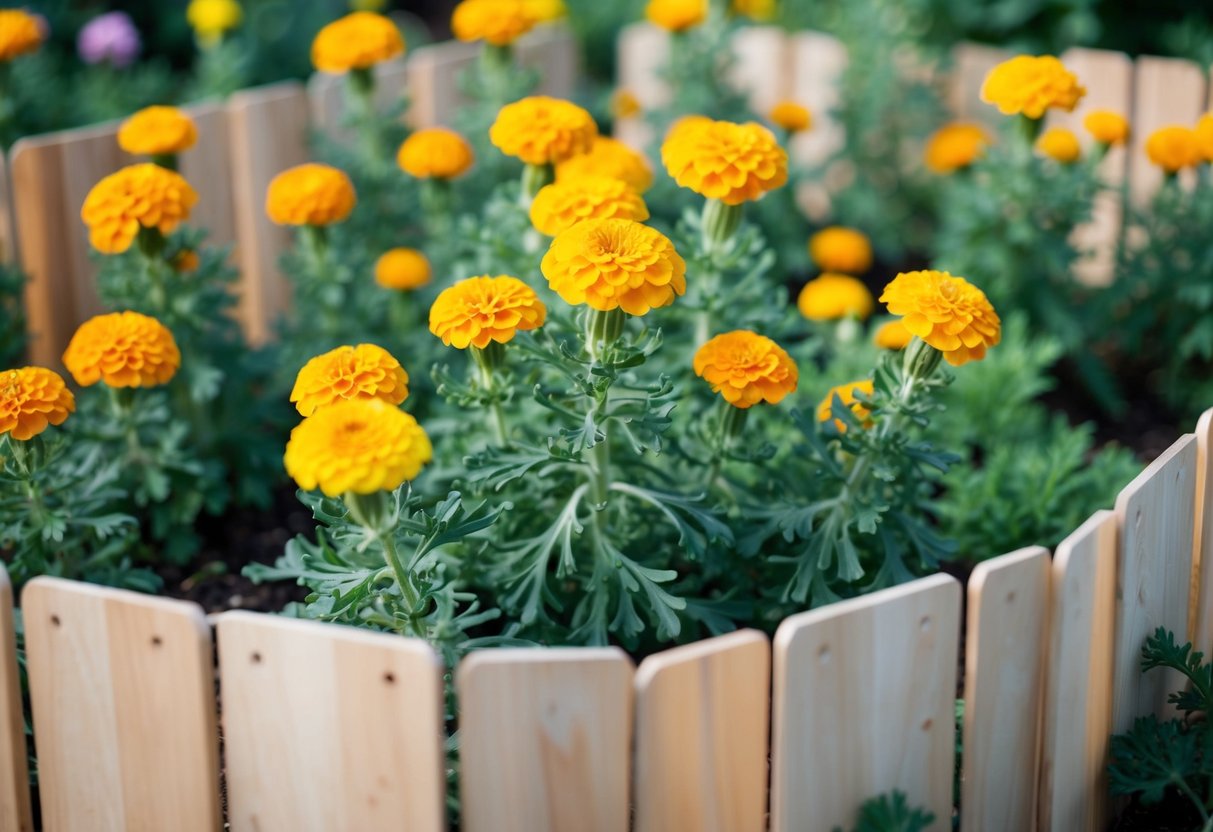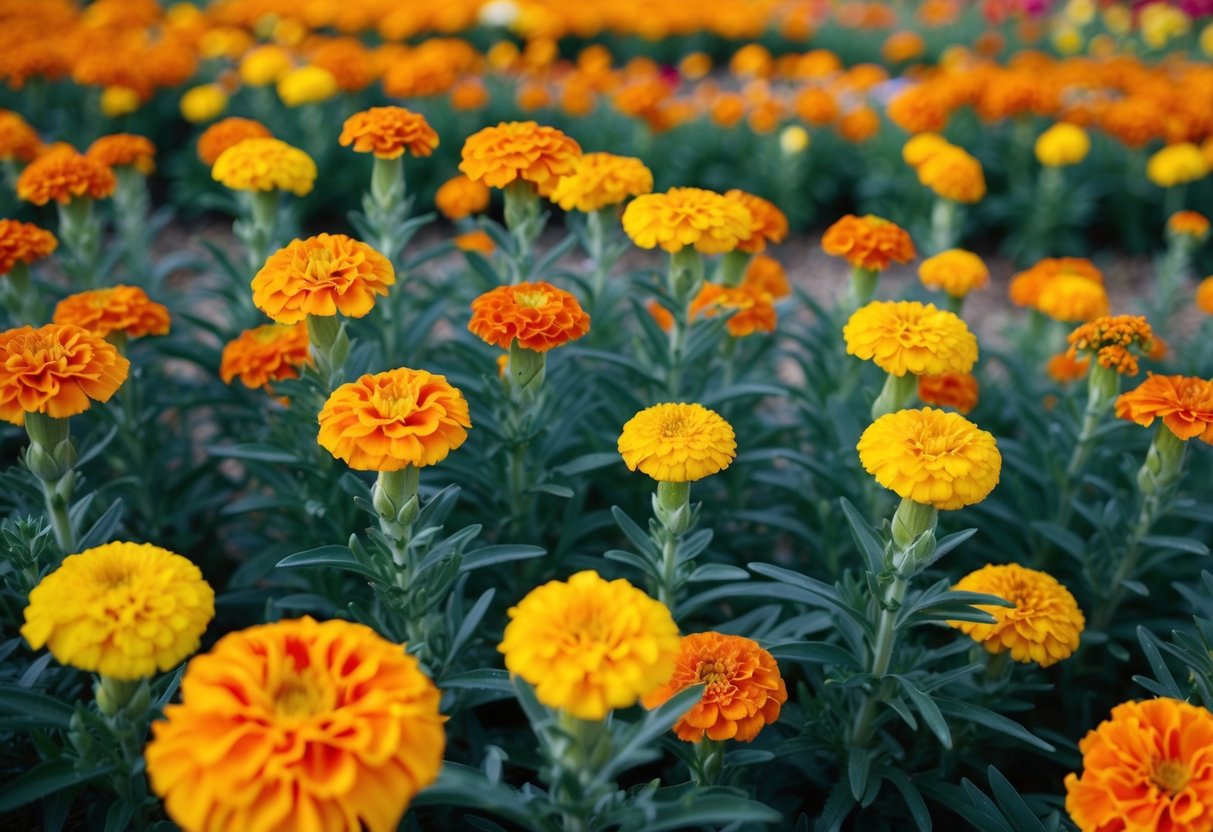Do Marigolds Multiply? A Guide to Growing More Blooms
When you’re thinking about adding some color to your garden, marigolds might be one of the first flowers to consider. Their vibrant colors not only brighten up any space, but they also have practical benefits.
Yes, marigolds do multiply if left unattended, making them an excellent choice for gardeners looking for a low-maintenance way to expand their garden naturally.

As marigolds grow and spread, they can fill your garden with an array of yellow, orange, gold, and even maroon blooms. These plants are not just easy to grow, but they’re also known for repelling pests, which can help protect other plants in your garden.
Planting marigolds near vegetables like tomatoes and peppers can result in healthier harvests, as they help ward off nematodes and other pests.
Starting with just a few marigold plants, you’ll soon find that these flowers bring both beauty and function. Whether you’re a seasoned gardener or just starting out, the self-multiplying nature of marigolds can quickly transform your garden into a vibrant haven.
Want to know how to make the most of marigolds in your backyard? Keep reading to learn more about this gardener’s favorite flower.
Getting to Know Marigolds

Marigolds are part of the Asteraceae family, known for their bright colors and easy maintenance. Understanding the different varieties and the historical significance of these flowers can enrich your gardening experience.
Varieties of Marigolds
There are several types of marigolds, each with unique qualities. The French marigold is compact, making it perfect for borders and containers. They bloom in bold colors like orange, yellow, and red.
The African marigold, also known as the Tagetes erecta, grows taller and features larger blooms, making a striking display in gardens.
For something different, you might enjoy the Signet marigold. Known for its citrusy scent, this type is less common but adds a unique flavor to your garden.
Calendula, often confused with true marigolds, shares the same vibrant colors but is a different plant. Cultivars of these marigolds offer a range of forms and sizes, all carrying the common name “marigold.”
Historical Significance
Marigolds have held importance in various cultures over the years. They have been associated with religious ceremonies and festivals. In ancient times, marigolds were admired for their vibrant hues and used in rituals.
In Mexico, marigolds, specifically the Tagetes, are linked to Día de los Muertos. The flowers are believed to guide spirits to their loved ones. In India, marigolds are often used in large quantities for decorations in festivals and weddings.
Understanding the historical context of these bright flowers adds depth to your appreciation. While marigolds may be common in gardens today, their rich past and diverse uses show their enduring cultural relevance.
Cultivation and Care

Marigolds thrive when given the proper conditions and care. Key aspects include ample sunlight, well-draining soil, and regular maintenance to keep plants healthy and blooming. Understanding each factor ensures your marigolds remain vibrant throughout the growing season.
Optimal Growing Conditions
Marigolds love full sun, requiring at least 6 to 8 hours of direct sunlight a day. When growing marigolds, choose a spot in your garden that offers plenty of sunlight.
They prefer well-draining soil with a neutral pH between 6.0 and 7.0. Although marigolds are fairly drought-tolerant, they benefit from soil that’s not too acidic or heavy.
To enrich poor soil, mix in some compost or well-rotted manure, which can enhance drainage and provide nutrients. If you’re using containers, ensure the potting soil is amended for good drainage.
These conditions help marigolds establish strong roots and produce abundant blooms.
Planting and Transplanting
Start marigold seeds indoors 4 to 6 weeks before the last expected frost, or sow them directly outdoors when the ground has warmed.
When planting marigolds, space French and signet types 8 to 10 inches apart, while larger African marigolds need 10 to 12 inches of space between them.
If you’re dealing with transplants, gently remove them from their pots without disturbing the roots. After placing them in the garden or containers, water each plant thoroughly to help settle the soil around the roots and minimize transplant shock. This will encourage healthy growth from the start.
Watering and Fertilization
Marigolds need consistent moisture but are also tolerant to short dry periods. Water deeply once or twice a week, more during hot spells, aiming for the soil to stay evenly moist but not waterlogged.
Overwatering can lead to root rot, so ensure good drainage. In pots, check that excess water can escape easily.
For fertilization, marigolds generally thrive without much need, but a monthly dose of a balanced fertilizer can boost their growth. If you prefer organic methods, a little side-dressing of compost can serve the same purpose, enriching the soil and promoting blooms.
Pruning and Maintenance
Regular maintenance keeps your marigolds tidy and blooming well. Deadhead spent blooms frequently to encourage new flowers and prevent the plants from setting seed prematurely.
This also helps the plant direct its energy to producing more vibrant flowers instead of focusing on seed production.
Pruning marigolds involves pinching the tips of the branches to promote bushier growth. Remove any diseased or damaged foliage promptly to maintain plant health. Consistent care ensures your marigolds remain attractive and flourish throughout the season.
Propagation and Multiplication

Marigolds are known for their easy propagation and ability to multiply. You can grow marigolds through various methods that include careful seeding, deadheading, and taking advantage of their self-seeding nature. Proper gardening techniques can enhance the growth and multiplication of these vibrant flowers.
Seeding and Deadheading
When growing marigolds, starting with marigold seeds is a popular method. Sowing them in springtime offers the best results.
For success, you should plant seeds in warm, moist soil as this encourages germination. Be patient as they sprout, and soon you’ll see the vibrant blooms.
Deadheading is an important technique. By removing spent flowers, you redirect the plant’s energy into producing new blooms rather than seeds.
This not only keeps your garden looking tidy but also stimulates the plant to produce more flowers. Regular deadheading can lead to a fuller and more vibrant display. Remember, the key is to gently snip the old flowers to encourage new blossoms.
Self-Seeding and Division
Marigolds have a wonderful ability to self-seed if left to their own devices. Allowing flowers to drop seeds naturally can lead to new plants emerging the following season.
This method requires minimal effort and can result in a surprising and delightful scattering of marigolds throughout your garden.
Another effective way to multiply marigolds is by division. Although marigolds are typically annuals, dividing at the end of the season can sometimes yield fresh plants.
Carefully separate the established plant into smaller sections and replant them to create more clusters of colorful blooms. This method helps manage space and rejuvenate older plants for another growing season.
Protecting Marigolds from Troubles

Keeping your marigolds healthy involves managing both diseases and pests. Ensuring good air circulation and practicing companion planting can minimize issues.
Common Diseases
Marigolds can fall victim to several plant diseases. Powdery mildew is a common problem that appears as a white, powdery substance on the leaves. It thrives in conditions with poor air circulation. To prevent this, make sure plants are spaced properly to allow for airflow.
Root rot, caused by overwatering, can lead to wilting. Ensure soil drains well to avoid this problem. Another disease, aster yellows, affects plant growth and is spread by insects.
To address these issues, keep the garden clean and remove infected plants promptly. Using disease-resistant marigold varieties can also help. Regular monitoring allows you to detect problems early.
Pest Management and Companion Planting
Marigolds have natural pest-repellent properties. They effectively deter nematodes, especially root-knot nematodes, which attack your plant roots.
Plant marigolds near tomatoes, peppers, or potatoes to protect these plants from pests.
A strong pungent smell of marigolds helps keep rabbits, deer, and other animals away. For aphids and spider mites, inspect your plants regularly and hose off any infestations.
Encourage beneficial insects such as ladybugs by planting marigolds alongside herbs or other friendly plants.
Companion planting not only protects your garden but can enhance growth and yield. Integrating marigolds with the right plants maximizes their protective benefits and ensures a thriving garden environment.
Marigolds in Gardens and Landscapes

Marigolds are versatile flowers, making them a great choice for gardens and landscapes. You can use them in creative designs and enjoy the benefits they bring to wildlife.
Designing with Marigolds
Marigolds can brighten up many garden styles. Whether you have a formal landscape, a casual cottage garden, or practice container gardening, marigolds fit in well.
These flowers work beautifully as borders and in mixed flower beds. Their bright colors, like yellow and orange, catch the eye.
You can also incorporate marigolds into a vegetable garden. They help deter pests naturally. This makes them valuable companions for crops.
Marigolds are also ideal as cut flowers. You can use them in bouquets to add cheer to your home.
In addition, marigolds are often used in festivals due to their vibrant blooms. They symbolize positivity and joy. This makes them perfect for decorative purposes. With their easy maintenance and sunny colors, marigolds are a top choice for gardeners.
Marigolds and Wildlife
Marigolds play a crucial role in attracting and supporting wildlife. Their bright blooms attract pollinators such as bees and butterflies. These insects are essential for the health of your garden ecosystem as they aid in the pollination of various plants.
Marigolds may also serve as a food source for some beneficial insects. While marigolds are not typically known as edible flowers, they can be attractive to other garden dwellers who help control pests.
Including marigolds in your landscape boosts biodiversity. They create a lively environment that supports different forms of life. This makes your garden not only a beautiful space but a healthy one as well. By planting marigolds, you contribute positively to both your surroundings and the broader ecosystem.







